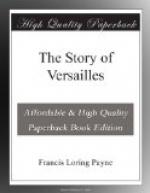The appearance of the villa erected by Louis XIII had been vastly altered as to its roofs, chimneys, facades. In 1665 the court was ornamented by the placing of the pedestals and busts that still surround it. In addition to the main edifice, the King gave orders for the building of small dwellings to be occupied by favorites of his entourage, and by musicians, actors and cooks. Three broad tree-lined avenues were laid out and the highway to Paris—the Cours-la-Reine—commenced. Already Versailles took on a more imposing aspect than ancient Fontainebleau. Workmen were constantly busy with the building of reservoirs, the laying of sod, the planting of labyrinths, hedges, secret paths and bosky retreats, with the setting out of hundreds of trees brought from Normandy, and the seeding of flower gardens of surpassing beauty. Ponds, fountains, grottoes, waterfalls and straying brooks came into being at the command of the ambitious young ruler. At some distance from the chateau courts and cages were constructed to shelter rare birds and animals. It was designed that this should be “the most splendid palace of animals in the world.” The King decided the details of building and decoration and supervised the installation of the furred and feathered tenants of the palatial menagerie. This was the enclosure so greatly admired by La Fontaine, Racine and Boileau, during a visit to Versailles in 1668.
The first epoch of the construction of Louis XIV coincided with the first sculptural decoration of Versailles. A great number of works of art were ordered for the adornment of the walks and gardens. Many statues and busts of mythological subjects that were made at Rome to the order of Fouquet, after models by Nicolas Poussin, were removed from Vaux to Versailles. That was a thriving period for sculptors of France and adjacent countries. Records faithfully kept by Colbert detail expenditures of thousands of pounds of the nation’s money for bronze vases, stone figures of nymphs and dryads and dancing fauns that were placed among the trees and fountains of Versailles. Much of the ornamental sculpture ordered at this time disappeared from the royal domain, as Louis XIV constantly demanded the work of the newest artists and all the novelties of the moment.
By the year 1668 Versailles apparently approached completion. It had then been seven years in building. But in 1669 the general character of the chateau was again changed. In the embellishments proposed by Le Vau, the architect, the royal domain became the scene of renewed activity, engendered by the King, then just turned thirty years of age, and eager to achieve still greater improvements at Versailles to mark the increasing prosperity of his reign. Half-finished buildings were demolished and begun anew. Immense structures arose, and once again artists flocked to Versailles. Inside the palace and in the park they wrought an elaborate scheme of decoration that made this the most sumptuous dwelling




